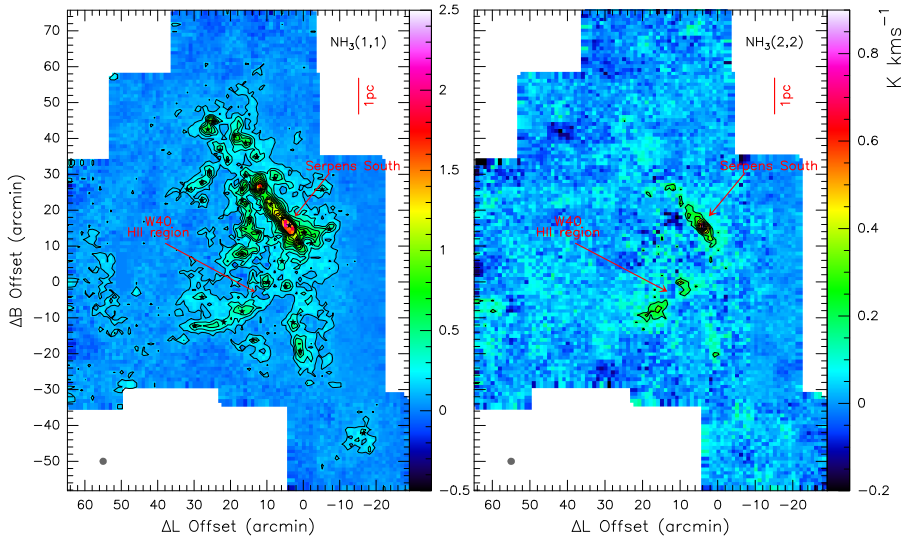

Ammonia observations towards the Aquila Rift cloud complex
Ammonia (NH3) is frequently used as the standard molecular cloud thermometer (e.g., Ho & Townes 1983; Walmsley & Ungerechts 1983). NH3 (1,1) and (2,2), both belonging to the para-species of ammonia, have been proven to be an excellent thermometer at Tkin < 40 K.. The critical densities of NH3 (1,1) and (2,2) are about 103 cm-3 (Evans 1999; Shirley 2015), thus providing a proper tracer for dense regions.
We map the Aquila Rift complex including the Serpens South and W 40 regions in the NH3 (1,1) and (2,2) transitions making use of the Nanshan 26-m telescope. The kinetic temperature of the dense gas in the Aquila rift cloud complex measured by NH3 (2,2)/(1,1) line ratios ranges from 8.9 to 35.0 K with an average of 15.3 ± 6.1 K. The high mass-star formation region of W 40 has a gas kinetic temperature of ~25 K, which is twice that (~12 K) found in the Low mass-star formation region of Serpens South. A comparison of kinetic temperatures derived from NH3 and dust emission indicates that gas and dust temperatures are in agreement in Serpens South, but gas temperatures are higher than those of the dust in W 40.
Dense gas traced by NH3 is significantly influenced by supersonic non-thermal motions. The non-thermal velocity dispersion of NH3 (1,1) is positively correlated with the gas temperature, which indicates that the dense gas may be heated by dissipation of turbulent energy. Weak velocity gradients demonstrate that the rotational energy is a negligible fraction of the gravitational energy. The Serpens South has total NH3 fractional abundances with an average of 8.6 (±3.8) × 10-8. Lower values of 0.1 – 4.3 × 10-8 with an average of 1.6 (±1.4) × 10-8 characterize W 40, which is a factor of approximately five below the result from Serpens South.

Ammonia observations towards the Aquila Rift cloud complex using the Nanshan 26-m telescope. Integrated intensity maps of NH3 (1,1) (left) and (2,2) (right).
Contact: Kadirya·Tursun
Xinjiang Astronomical Observatory, Chinese Academy of Sciences
Email: kadirya@xao.ac.cn
Article link: https://doi.org/10.1051/0004-6361/202037659
Attachment Download: